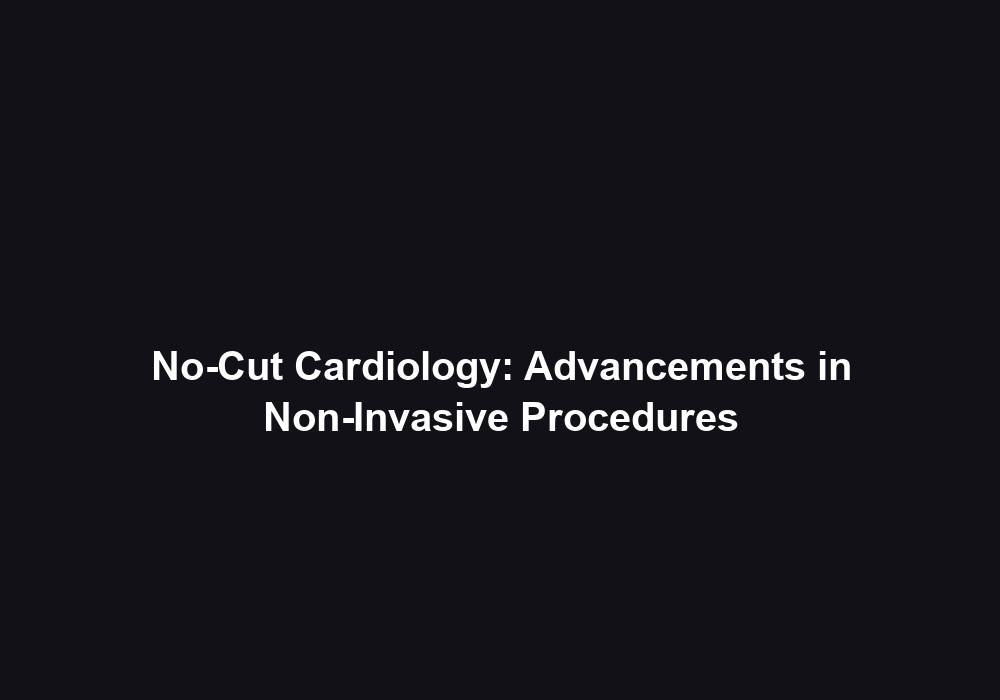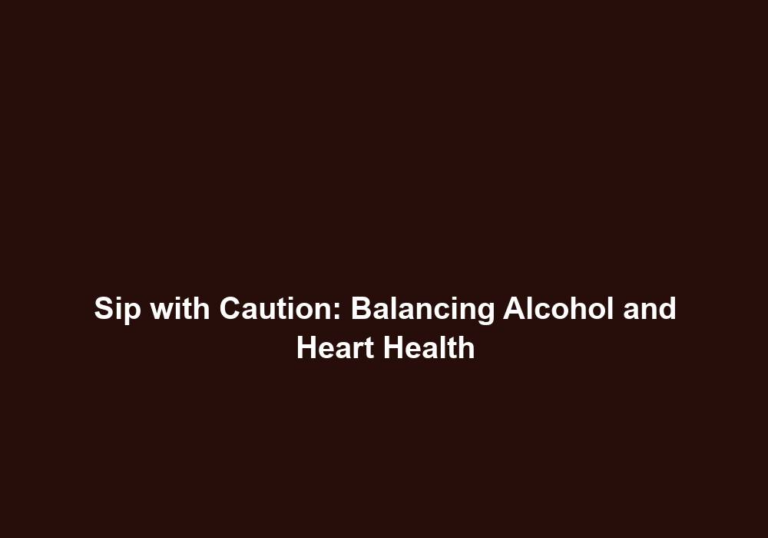No-Cut Cardiology: Advancements in Non-Invasive Procedures
Cardiovascular diseases are a leading cause of death worldwide, and their diagnosis and treatment have traditionally involved invasive procedures such as open-heart surgery. However, with advancements in medical technology, non-invasive cardiology procedures have emerged as a revolutionary alternative. These innovative procedures offer numerous benefits, including reduced risks, faster recovery times, and increased patient comfort. In this article, we will explore the recent advancements in no-cut cardiology, highlighting the techniques and technologies that have transformed the field.
Introduction to No-Cut Cardiology
No-cut cardiology, also known as non-invasive cardiology, refers to medical procedures that do not require any incisions or cuts into the body. These procedures utilize imaging techniques and minimally invasive tools to diagnose and treat various cardiovascular conditions. The primary goal of no-cut cardiology is to provide effective and safe alternatives to traditional surgical interventions, minimizing patient discomfort and optimizing outcomes.
Non-invasive cardiology has revolutionized the field with its ability to accurately diagnose and treat cardiovascular diseases without the need for invasive procedures. By utilizing advanced imaging techniques and minimally invasive tools, physicians are able to visualize the heart and its structures in real-time, providing valuable insights into the condition of the patient’s heart. These techniques have transformed the way cardiovascular diseases are diagnosed, allowing for early detection and intervention.
Key Advancements in No-Cut Cardiology
1. Cardiac Imaging Techniques
Non-invasive cardiac imaging plays a crucial role in diagnosing cardiovascular diseases accurately. Several advanced imaging techniques have revolutionized the field, allowing physicians to visualize the heart without the need for invasive procedures. These techniques include:
-
Echocardiography: This imaging technique uses ultrasound waves to create real-time images of the heart’s structure and function. It helps in assessing the heart valves, chambers, and blood flow, aiding in the diagnosis of conditions such as heart failure, valve abnormalities, and congenital heart defects. Echocardiography is a non-invasive and safe procedure that provides detailed information about the heart’s condition, allowing for targeted treatment plans.
-
Cardiac Magnetic Resonance Imaging (MRI): MRI utilizes powerful magnets and radio waves to produce detailed images of the heart. It provides valuable information about the heart’s structure, blood flow, and tissue characteristics. Cardiac MRI is particularly useful in evaluating myocardial viability, diagnosing ischemic heart disease, and assessing the extent of damage after a heart attack. This non-invasive procedure allows for accurate diagnosis and personalized treatment plans.
-
Computed Tomography (CT) Angiography: CT angiography involves the injection of a contrast dye into the bloodstream to visualize the coronary arteries. It helps in detecting blockages, narrowing, or other abnormalities in the arteries, aiding in the diagnosis of coronary artery disease. CT angiography is a non-invasive alternative to traditional angiography, eliminating the need for invasive procedures and reducing patient discomfort.
These advanced imaging techniques have revolutionized the field of cardiology by providing detailed and accurate information about the heart’s condition without the need for invasive procedures. They have significantly improved the diagnosis and treatment of cardiovascular diseases, leading to better patient outcomes.
2. Interventional Cardiology Procedures
Non-invasive cardiology also encompasses interventional procedures that treat cardiovascular conditions without the need for open-heart surgery. These procedures are performed using catheters, which are thin, flexible tubes inserted through blood vessels, usually in the groin or wrist. Key advancements in interventional cardiology include:
-
Angioplasty and Stenting: Angioplasty is a procedure that uses a balloon-tipped catheter to open up blocked or narrowed arteries. Stenting involves the placement of a small, mesh-like metal tube (stent) to keep the artery open. This technique is commonly used to treat coronary artery disease and restore blood flow to the heart. Angioplasty and stenting are minimally invasive procedures that provide immediate relief to patients with blocked arteries, reducing the need for open-heart surgery.
-
Transcatheter Aortic Valve Replacement (TAVR): TAVR is a minimally invasive alternative to open-heart surgery for patients with severe aortic stenosis. During this procedure, a collapsed artificial valve is inserted through a catheter and deployed within the native aortic valve, restoring normal blood flow. TAVR offers a less invasive and safer option for patients who are at high risk for open-heart surgery, allowing for quicker recovery and improved quality of life.
-
Percutaneous Coronary Intervention (PCI): PCI, also known as coronary angioplasty, is performed to treat blocked coronary arteries. It involves the use of a catheter with a small balloon at its tip, which is inflated to widen the narrowed artery. Additionally, a stent may be placed to maintain the vessel’s patency. PCI is a minimally invasive procedure that effectively restores blood flow to the heart, reducing the need for open-heart surgery and improving patient outcomes.
These interventional cardiology procedures have revolutionized the treatment of cardiovascular diseases by providing less invasive alternatives to open-heart surgery. They offer patients faster recovery times, reduced risks, and improved quality of life.
3. Non-Invasive Diagnostic Tests
Advancements in non-invasive diagnostic tests have significantly contributed to the early and accurate detection of cardiovascular diseases. These tests are painless, require no surgical intervention, and provide valuable information for effective treatment planning. Notable non-invasive diagnostic tests include:
-
Electrocardiogram (ECG): ECG measures the electrical activity of the heart and helps detect abnormal heart rhythms, myocardial ischemia, and structural abnormalities. It is a simple and non-invasive test that provides valuable insights into the heart’s condition.
-
Holter Monitoring: Holter monitoring involves wearing a portable device that continuously records the heart’s electrical activity for a certain period, usually 24 to 48 hours. It aids in diagnosing intermittent cardiac arrhythmias, evaluating the effectiveness of medications, and assessing overall heart health. Holter monitoring is a non-invasive and convenient method of monitoring the heart’s activity over an extended period.
-
Exercise Stress Testing: This test involves monitoring the heart’s response to physical exertion, usually on a treadmill or stationary bicycle. It helps in diagnosing heart disease, evaluating exercise capacity, and assessing the effectiveness of treatments. Exercise stress testing is a non-invasive and reliable method of assessing the heart’s function and identifying any abnormalities.
These non-invasive diagnostic tests have revolutionized the early detection and monitoring of cardiovascular diseases. By providing valuable information without the need for invasive procedures, they allow for timely intervention and personalized treatment plans.
Benefits of No-Cut Cardiology
No-cut cardiology procedures offer several advantages over traditional invasive techniques. These benefits include:
-
Reduced Risks: Non-invasive procedures minimize the risks associated with open-heart surgery, such as infection, bleeding, and complications related to anesthesia. By avoiding invasive procedures, patients experience fewer complications and have a lower risk of adverse events.
-
Faster Recovery Times: Patients undergoing non-invasive procedures typically experience shorter hospital stays, faster recovery times, and a quicker return to their daily activities. By avoiding the trauma of open-heart surgery, patients can resume their normal lives sooner.
-
Enhanced Patient Comfort: No-cut cardiology procedures are generally less painful and less traumatic for patients. They eliminate the need for large incisions, reducing post-operative discomfort. Patients experience less pain and have a better overall experience with non-invasive procedures.
-
Lower Healthcare Costs: Non-invasive procedures often result in cost savings for patients, as they require fewer hospital resources and shorter hospital stays. By avoiding open-heart surgery, patients can save on healthcare costs and reduce the financial burden associated with invasive procedures.
-
Less Scarring: Since non-invasive procedures do not involve surgical incisions, they leave little to no visible scarring, improving cosmetic outcomes. Patients can enjoy better cosmetic results and a higher level of satisfaction with their appearance.
Non-invasive cardiology procedures have transformed the field by providing safer and more comfortable alternatives to traditional open-heart surgeries. They offer numerous benefits, including reduced risks, faster recovery times, enhanced patient comfort, lower healthcare costs, and improved cosmetic outcomes.
Conclusion
The field of cardiology has witnessed remarkable advancements in non-invasive procedures, offering patients safer and more comfortable alternatives to traditional open-heart surgeries. No-cut cardiology techniques, including advanced imaging, interventional procedures, and non-invasive diagnostic tests, have revolutionized the way cardiovascular diseases are diagnosed and treated. These advancements have significantly improved patient outcomes and have the potential to transform the landscape of cardiovascular care. As technology continues to evolve, the future of no-cut cardiology looks promising, with further advancements expected to enhance patient care and improve overall cardiovascular health.







